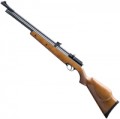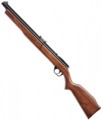Muzzle velocity
The muzzle velocity provided by the rifle - that is, the speed of the bullet as it exits the barrel.
All other things being equal, a higher bullet speed provides greater range and accuracy, and also simplifies aiming at long distances: the bullet flies along a smoother trajectory and requires fewer adjustments in height, and the influence of side winds decreases with increasing speed. On the other hand, this indicator directly affects the price of the rifle; and in some countries, legal restrictions on the ownership of pneumatic weapons are also related to the muzzle velocity of the bullet.
As for specific values, in the weakest modern rifles the initial speed does not exceed
150 m/s, and in the most powerful it can be
300 - 350 m/s or even
more(remember, the speed of sound is 330 m/s). In general, for recreational shooting at short distances, this parameter is not particularly important, and detailed recommendations for choosing pneumatics for more specific situations can be found in special sources. Let us only note that in AEG electric drives (see “Type”) the initial speed extremely rarely exceeds 150 m/s, but this is done solely for safety reasons: such “weapons” are intended for military-tactical games and initially involve shooting at people, and the high speed would be unsafe for players even with protective equipment.
It is also wor
...th considering that this indicator is not strictly defined. In any type of pneumatic it depends on the weight of the bullet (the lighter the faster); therefore, in the characteristics it is usually customary to indicate a certain average velocity for standard ammunition (usually weighing 0.5 g, in AEG - 0.2 g). In addition, in multi-compression rifles the actual speed of the bullet is determined by the degree of inflation, in gas-cylinder rifles it is determined by the ambient temperature, and in PCP models it is possible to achieve higher speeds than declared by replacing the air with a special gas (for example, helium). Nevertheless, this characteristic makes it possible to evaluate the capabilities of the rifle and compare it with other models, including those that differ in type.Charging
Load capacity determines the amount of ammunition that can fit in a rifle's magazine at one time.
—
Single shot. As the name suggests, these rifles can only hold one bullet, usually directly in the chamber (back of the barrel); You have to reload your weapon after every shot. This is not very convenient due to the need for additional manipulations, and the rate of fire suffers significantly. At the same time, single-shot rifles are usually quite simple in design, which ensures, on the one hand, reliability, and, on the other hand, low cost.
—
Multi -charged. Rifles that can hold multiple bullets or pellets in a single charge. For their placement, special devices are used — removable or non-removable stores, drums, etc. The capacity is usually between five and several dozen rounds of ammunition. At the same time, for "omnivorous" models (see "Type of ammunition"), the capacity for balls is usually higher than for lead bullets — often 2-3 times; there are even options that are multiply charged only when using balls — bullets in them can only be loaded one at a time. The advantage of a multi-shot weapon over a single-shot weapon is obvious: you can fire several shots from it without being distracted by reloading. Reloading itself, if more difficult, is not much. On the other hand, due to the complexity of the design, such models are significantly more expensive; and in some types of pneum
...atics (see above), multiply charged is not applicable by definition.Magazine capacity
And in models like AEG (see “Type”) and other airsoft weapons, the capacity is indicated for the standard magazine supplied in the kit; in this case, the magazine, as a rule, is removable, and if desired, it can be replaced with another one that differs in capacity. It is worth noting here that airsoft magazines are usually divided into “bunkers” (high capacity) and “mechanics” (low capacity). Mechanas typically hold up to 150 pellets, and some of these magazines have the same capacity as real weapons. This variety is appreciated by lovers of realism and experienced players. In “bunkers,” in turn, the capacity is already hundreds, and sometimes thousands, of bullets. They are convenient for beginners and undemanding airsoft players, but a serious drawback of such magazines is noise - the balls, hanging in the main compartment of the “bunker”, turn it into a rattle, making it difficult to move covertly.
Scope mount
The type of mount for mounting sights provided in the design of the rifle. Most often in such cases we are talking about an optical or collimator sight; and the most popular mounting options are
Weaver/Picatinny rail and
dovetail. Here are their features:
— "Dovetail". This type of mount has a cross-sectional view of an inverted trapezoid (expanding upwards); the clamp on the sight covers this trapezoid from two sides, and the transverse cutouts, unlike the Weaver / Picatinny rails, are not provided for in the design — fixing in place is carried out in other ways. Dovetail mounts were originally used in civilian hunting rifles, as well as in Soviet-style military weapons. Nowadays, due to their simplicity, low cost and versatility, they are extremely common in air rifles. In addition, we note that you can even install a Weaver / Picatinny rail on a dovetail (such rails are available separately) and use a sight with the appropriate type of mount.
— Weaver / Picatinny rail. Fastening in the form of a bar with a T-shaped profile and characteristic transverse slots — they serve to rigidly fix the installed accessories in one place. Technically, Weaver and Picatinny rails are different types of mounts, they differ in the size of the slots; these differences are such that the sights and other “body kit” for the Weaver rails easily get on the Picatinny rail, but the opposite option is far fro
...m always possible. However, in the civilian market, most weapon accessories for such slats are made specifically for the weaver, so this nuance, most often, is not fundamental, and both types of slats are combined into one category.
In general, for a number of reasons, such straps are much less common in air rifles than the dovetail. At the same time, classic pneumatics are most often equipped with Weaver mounts, but in airsoft copies of real weapons, Picatinny rails (or compatible NATO STANAG 4694 rails, also known as RIS 22 mm) can also be used.
— Is absent. The absence of any standard mounts for the sight in the design of the rifle. Most often, this designation means that the rifle is equipped with a classic front sight with a whole and does not require the installation of additional sights. However, there is also a more specific option — pneumatics, in which original mounts are used to install optics or a collimator, which are not related to the standards described above. Such rifles can be supplied with or without scopes; there are even models with non-removable optics, although extremely rare.
